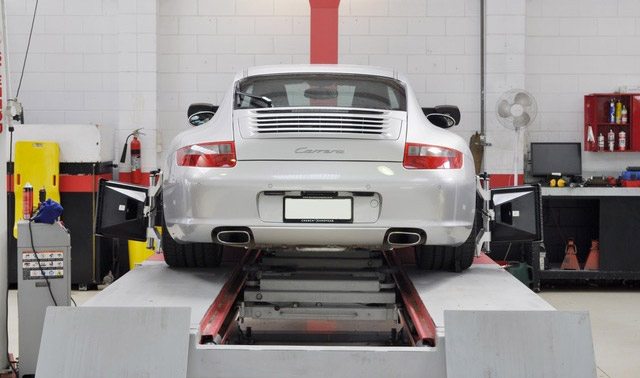Wheel alignment is making sure your car’s wheels are all pointing in the right direction. It’s important because it helps your car drive better and keeps your tyres lasting longer. Bay European knows the importance of proper wheel alignment for European cars. With their intricate mechanical systems and numerous adjustments, maintaining the ideal wheel alignment is the key for optimal performance and safety.
Why is wheel alignment so important?
Wheel alignment is important for several reasons. Firstly, it makes sure that your vehicle drives straight and true, preventing it from pulling to one side or the other. This improves both safety and comfort while driving.
Secondly, proper alignment helps to extend the lifespan of your tyres by making sure that they wear evenly. When your wheels are properly aligned, all four tyres bear the vehicle’s weight evenly, reducing unnecessary wear and tear.
Additionally, wheel alignment contributes to fuel efficiency. Misaligned wheels can cause your vehicle to work harder, leading to increased fuel consumption.
Lastly, maintaining proper alignment also preserves your vehicle’s suspension components, preventing premature wear and potential damage.
In short, wheel alignment plays a key role in safety, tyre longevity, fuel efficiency, and overall vehicle performance. It’s an important aspect of regular vehicle maintenance.

Signs your car need wheel alignment
Recognising the signs that your car needs wheel alignment is key for maintaining its performance and safety on the road. Here are some common indicators to look out for:
Uneven tyre wear: One of the most noticeable signs is uneven tyre wear. Inspect your tyres regularly for signs of wear, particularly on the tread. If you notice that one side of the tyre tread is wearing out faster than the other, it could indicate misaligned wheels.
Steering wheel vibration: Another sign to watch for is vibrations felt through the steering wheel while driving. If you feel a shaking or vibrating sensation, especially at higher speeds, it may be a symptom of misaligned wheels.
Vehicle pulling: A car that pulls to one side while driving on a straight road is often a sign of wheel misalignment. If you find yourself constantly adjusting the steering to keep the car straight, it’s likely that your wheels need alignment.
Crooked steering wheel: Take a moment to observe your steering wheel while driving on a straight, level road. If the steering wheel is off-centre or crooked when the car is travelling straight, it may indicate alignment issues.
Squealing tyres: Misaligned wheels can cause excessive friction between the tyres and the road surface, leading to squealing or screeching noises when turning corners or manoeuvring the vehicle.
Overall handling issues: If your car feels less stable or responsive than usual, it could be due to wheel misalignment. Poor handling, difficulty steering, or a general sense of instability may all be signs of alignment problems.
Regular inspection: It’s important to perform regular visual inspections of your tyres and pay attention to any changes in driving behaviour.
If you notice any of these signs, it’s a good idea to have your wheel alignment checked by a qualified mechanic. Addressing alignment issues right away can help prevent further damage to your tyres and give you a better, safer driving experience.
Book an appointment today
Our knowledgeable mechanics are always ready to address any questions or concerns you may have regarding your car. We will provide you with a detailed explanation of the alignment process, the adjustments made, and the benefits you can expect.
Contact us today to schedule your wheel alignment service and give your European car the attention it deserves.

